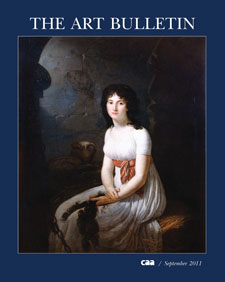CAA News Today
September Issue of The Art Bulletin Features Essays on Michelangelo and John Sloan
posted by Christopher Howard — Aug 17, 2011
 The September 2011 issue of The Art Bulletin, the leading publication of international art-historical scholarship, features an essay on Michelangelo’s drawings, in particular his cartoon for The Battle of Cascina (1504), and an article on urban scenes by the twentieth-century American painter John Sloan. Two additional contributions explore women and portraiture in postrevolutionary France and Roman mosaic labyrinths in North Africa. Book reviews on the art of Byzantium and imperial China, Mamluk culture, and the impact of modernist primitivism round out the issue.
The September 2011 issue of The Art Bulletin, the leading publication of international art-historical scholarship, features an essay on Michelangelo’s drawings, in particular his cartoon for The Battle of Cascina (1504), and an article on urban scenes by the twentieth-century American painter John Sloan. Two additional contributions explore women and portraiture in postrevolutionary France and Roman mosaic labyrinths in North Africa. Book reviews on the art of Byzantium and imperial China, Mamluk culture, and the impact of modernist primitivism round out the issue.
In “Michelangelo, Drawing, and the Subject of Art,” Joost Keizer uncovers Michelangelo’s zeal for disegno, evasion of iconography, and emphasis on educational models for pupils—all of which contribute to art history via visual commentary on historical moments. In his study, Michael Lobel examines the significant body of work generated by John Sloan in 1907 that experiments with spatial orientation and pigment while challenging the artist’s identity as a painter, illuminated by meditations on New York as a shifting metropolis and his background in illustration.
Amy Freund’s cover essay for The Art Bulletin elucidates the importance of portraiture in France after 1789 in which female portraits, like that of Thérésia Cabarrus by Jean-Louis Laneuville in 1796, incorporated women into the French Revolution’s political presence and momentum toward engaged citizenship in the new republic. In “Roman Labyrinth Mosaics and the Experience of Motion,” Rebecca Molholt explores the effects of a transitory viewing experience within Roman baths in North Africa and the intermingling of architecture, myth, and the spectator.
The Reviews section has a particular emphasis on ancient cultures, starting with Jessica Rawson’s discussion of ancient commercial artists in China and Anthony J. Barbieri-Low’s book, Artisans in Early Imperial China. Charles Barber highlights the complexities of the Byzantine icon through the lens of innovations in fifteenth-century Cretan painting, as well as the sensory experience in Byzantium as described by Clemena Antonova in Space, Time, and Presence in the Icon and Bissera V. Pentcheva’s The Sensual Icon. Several books on the history of the Mamluk period, where military slaves became soldiers and eventually rulers of an empire across Egypt, the Arabian Peninsula, the Levant, and greater Syria, are reviewed by Heghnar Zeitlian Watenpaugh, including Cairo of the Mamluks by Doris Behrens-Abouseif. The final review is an analysis of the tension between African art and Western modernism by Elizabeth Harney, in which she sites Man Ray, African Art, and the Modernist Lens by Wendy A. Grossman and Picasso’s Collection of African and Oceanic Art by Peter Stepan as the newest sources to investigate the legacy of primitivism.
Please see the full table of contents for September to learn more. CAA sends The Art Bulletin to all institutional members and to those individuals who choose to receive the journal as a benefit of their membership.
The next issue of The Art Bulletin, to be published in December 2011, will feature essays on the portraiture of nuns in colonial Mexico, on the sociological context of Hokusai’s famous print Under the Wave off Kanagawa, and on Federico Zuccari’s painting The Encounter of Christ and Veronica on the Way to Calvary, among other articles and reviews.


